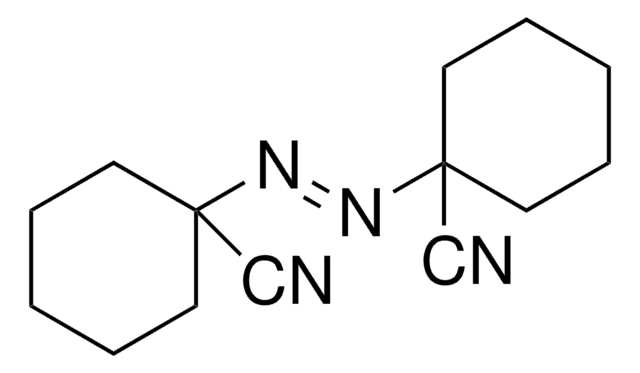440914
2,2′-Azobis(2-methylpropionamidine) dihydrochloride
powder or granules, 97%
Synonym(s):
α,α′-Azodiisobutyramidine dihydrochloride, AAPH
About This Item
Recommended Products
Quality Level
Assay
97%
form
powder or granules
t1/2
10 hr(56 °C)
mp
175-177 °C (lit.)
solubility
acetone, dioxane, methanol, ethanol, DMSO and water: soluble
SMILES string
Cl.Cl.CC(C)(\N=N\C(C)(C)C(N)=N)C(N)=N
InChI
1S/C8H18N6.2ClH/c1-7(2,5(9)10)13-14-8(3,4)6(11)12;;/h1-4H3,(H3,9,10)(H3,11,12);2*1H/b14-13+;;
InChI key
LXEKPEMOWBOYRF-QDBORUFSSA-N
Related Categories
Application
Polymerization initiator for acrylic, vinyl and allyl monomers.
Features and Benefits
Signal Word
Danger
Hazard Statements
Precautionary Statements
Hazard Classifications
Acute Tox. 4 Oral - Aquatic Acute 1 - Aquatic Chronic 1 - Eye Irrit. 2 - Self-heat. 1 - Skin Sens. 1
Storage Class Code
4.2 - Pyrophoric and self-heating hazardous materials
WGK
WGK 1
Flash Point(F)
Not applicable
Flash Point(C)
Not applicable
Choose from one of the most recent versions:
Already Own This Product?
Find documentation for the products that you have recently purchased in the Document Library.
Customers Also Viewed
Articles
Micro review of reversible addition/fragmentation chain transfer (RAFT) polymerization.
Protocols
Polymeric spheres serve as crystal templates. Synthesis methods yield large quantities.
We present an article about RAFT, or Reversible Addition/Fragmentation Chain Transfer, which is a form of living radical polymerization.
We presents an article featuring procedures that describe polymerization of methyl methacrylate and vinyl acetate homopolymers and a block copolymer as performed by researchers at CSIRO.
Polymerization via ATRP procedures demonstrated by Prof. Dave Haddleton's research group at the University of Warwick.
Our team of scientists has experience in all areas of research including Life Science, Material Science, Chemical Synthesis, Chromatography, Analytical and many others.
Contact Technical Service









